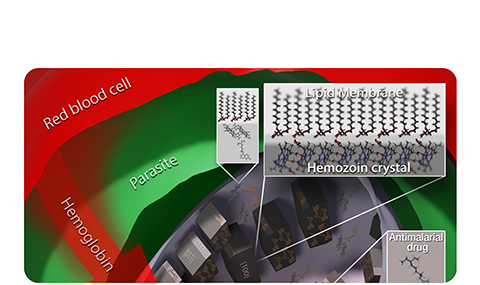Cholesterol, which is the most abundant sterol in mammalian cells, is a vital component of cell membranes and essential for cell viability. In biological systems cholesterol is mostly solubilized by incorporation in lipid membranes, bile salts, or with lipoproteins in blood.In cells, most of the cholesterol is located in the plasma membrane. Abnormally high levels of cholesterol may develop into detrimental precipitants containing cholesterol monohydrate crystallites that are associated with to atherosclerosis. We have therefore studied the nucleation of cholesterol monohydrate, first at the air-water interface, by grazing incidence X-ray diffraction (GIXD). We found that as a single bilayer, even hydrated at both sides, it is highly crystalline, appearing in a monoclinic two-dimensional arrangement different from that of the known triclinic form of cholesterol monohydrate. We have obtained three bilayers of the monoclinic cholesterol monohydrate at the air-water interface. These crystals eventually transform to the stable triclinic form of cholesterol monohydrate. When mixed with phospholipids in hydrated bilayer membranes, cholesterol will phase separate at a threshold concentration to form two-dimensional domains of monoclinic cholesterol monohydrate.
Finally, given that we had found in the 1990s by GIXD, that three different long-chain cholesteryl esters spontaneously form single crystalline bilayers in a structure akin to the monoclinic form of cholesterol monohydrate, we posit a possible role for one of the sterol esters in the crystallization of cholesterol·H2O in pathological environments. This is based on a composite of a crystalline bilayer of cholesteryl palmitate bound epitaxially as a nucleating agent to the monoclinic cholesterol·H2O form.
Several of the publications on which this work is based, are listed below.
Rapaport, H, Kuzmenko I, Lafont S, Kjaer K, Howes PB, Als-Nielsen J, Lahav M, Leiserowitz L. Cholesterol monohydrate nucleation in ultrathin films on water. Biophys. J. 2001, 81, 2729−2736.
Alonso C, Kuzmenko I, Jensen TR, Kjaer K, Lahav M, Leiserowitz L. Self-assembly of crystalline Films of Interdigitated long-chain cholesteryl esters at the air-water interface J Phys Chem B, 2001, 105, 8563-8568.
Solomonov, I.; Weygand, M. J.; Kjaer, K.; Rapaport, H.; Leiserowitz, L. Trapping crystal nucleation of cholesterol monohydrate: relevance to pathological crystallization. Biophys. J. 2005, 88, 1809−1817.
Ziblat, R.; Kjaer, K.; Leiserowitz, L.; Addadi, L. Structure of cholesterol/lipid ordered domains in monolayers and single hydrated bilayers. Angew. Chem. Int. Ed. 2009, 48, 8958−8961.
Ziblat, R.; Fargion, I.; Leiserowitz, L.; Addadi, L. Spontaneous formation of two-dimensional and three-dimensional cholesterol crystals in single hydrated lipid bilayers. Biophys. J. 2012, 103, 255−264.
Varsano, N.; Fargion, I.; Wolf, S. G.; Leiserowitz, L.; Addadi, L. Formation of 3D cholesterol crystals from 2D nucleation sites in lipid bilayer membranes: implications for atherosclerosis. J. Am. Chem. Soc. 2015, 137, 1601−1607.
Varsano, N.; F. Beghi, N. Elad, E. Pereiro, T. Dadosh, I. Pinkas, A. J Perez-Berna, X. Jin, H. S. Kruth, L. Leiserowitz, Lia Addadi. Two polymorphic cholesterol monohydrate crystal structures form in macrophage culture models of atherosclerosis. Proc. Natl. Acad. Sci. U.S.A. 2018, 115, 7662−7669.
M. Shepelenko, A. Hirsch, N. Varsano, F. Beghi, L. Addadi, L. Kronik, and Leiserowitz L. Polymorphism, Structure, and Nucleation of Cholesterol·H2O at Aqueous Interfaces and in Pathological Media: Revisited from a Computational Perspective. J. Am. Chem. Soc. 2022 https://doi.org/10.1021/jacs.1c10563.


